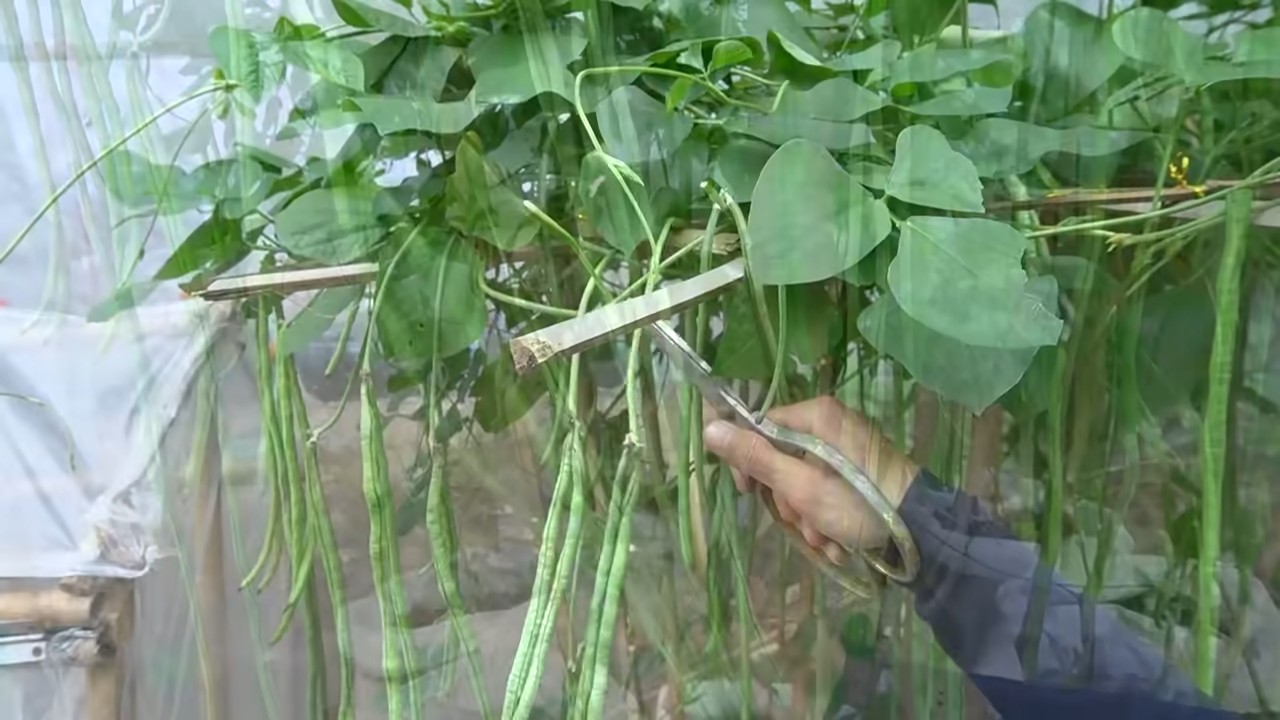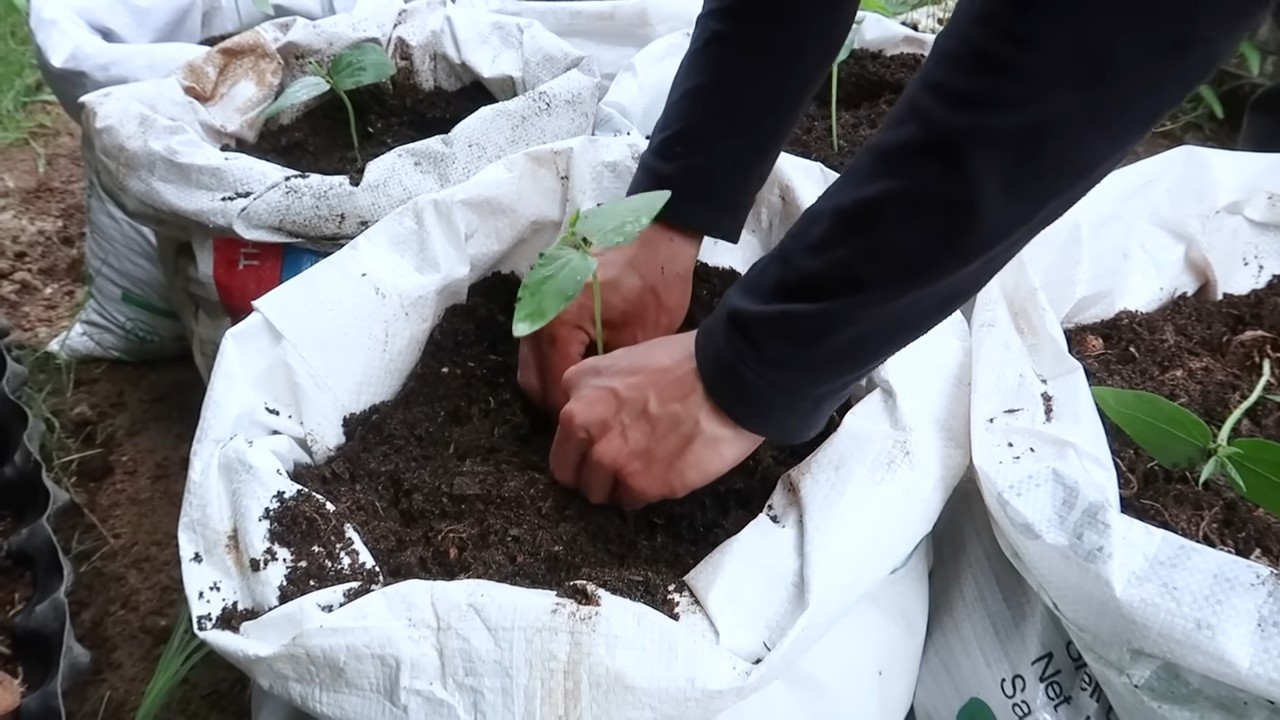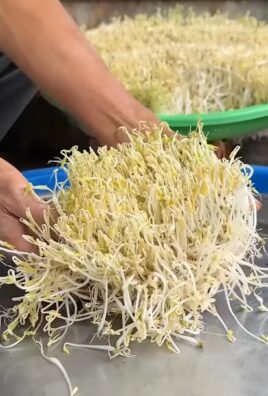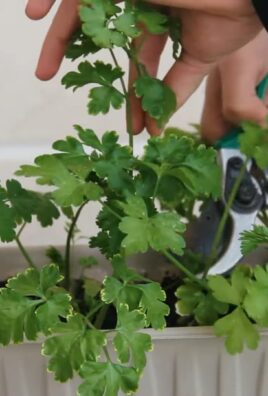Long bean growing tips are what you need to unlock a bountiful harvest right in your backyard! Have you ever dreamt of stepping outside and picking fresh, crisp long beans for your dinner? It’s more achievable than you think, and this guide is your secret weapon. For generations, long beans, also known as yardlong beans or asparagus beans, have been a staple in Asian cuisine, symbolizing prosperity and longevity. Their impressive length and delicious flavor have made them a beloved vegetable across cultures.
But let’s face it, sometimes growing your own food can feel intimidating. Maybe you’ve tried before and haven’t had the success you hoped for. That’s where these DIY tricks and hacks come in! I’m here to share easy-to-follow tips that will transform your gardening experience. With the right knowledge, even beginner gardeners can enjoy a thriving long bean patch. These long bean growing tips will help you avoid common pitfalls, maximize your yield, and enjoy the satisfaction of harvesting your own homegrown goodness. So, grab your gardening gloves, and let’s get started on this exciting journey together!

Growing Long Beans: A DIY Guide to a Bountiful Harvest
Hey there, fellow gardening enthusiasts! I’m so excited to share my tried-and-true methods for growing long beans, also known as yardlong beans or asparagus beans. These vigorous climbers are not only delicious but also add a unique vertical element to your garden. Get ready to impress your friends and family with your impressive harvest!
Choosing the Right Variety and Location
Before we dive into the nitty-gritty, let’s talk about selecting the right long bean variety and finding the perfect spot in your garden.
* Variety Selection: There are several long bean varieties available, each with slightly different characteristics. Some popular choices include ‘Red Noodle,’ ‘Chinese Red Noodle,’ ‘Orient Wonder,’ and ‘Yard Long.’ I personally love ‘Red Noodle’ for its vibrant color and excellent flavor. Consider your local climate and growing season when making your selection.
* Sunlight: Long beans are sun-worshippers! They need at least 6-8 hours of direct sunlight each day to thrive. Choose a location in your garden that receives ample sunlight throughout the day.
* Soil: Well-drained soil is crucial for long bean growth. They prefer slightly acidic to neutral soil with a pH between 6.0 and 7.0. Amend your soil with compost or other organic matter to improve drainage and fertility.
* Support Structure: Long beans are climbers, so they need a sturdy support structure to grow on. This could be a trellis, fence, arbor, or even a teepee made of bamboo poles. Make sure your support structure is at least 6-8 feet tall to accommodate their vigorous growth.
Step-by-Step Planting Guide
Now that you’ve chosen your variety and prepared your garden, let’s get planting!
1. Starting Seeds Indoors (Optional): While long beans can be directly sown into the garden, starting them indoors gives them a head start, especially in cooler climates. Start seeds 3-4 weeks before the last expected frost.
* Fill seed trays or small pots with a seed-starting mix.
* Sow seeds about 1 inch deep.
* Keep the soil moist but not soggy.
* Provide warmth and light (a heat mat and grow lights are helpful).
* Once the seedlings have developed a few sets of true leaves, they’re ready to be transplanted outdoors.
2. Direct Sowing: If you live in a warm climate with a long growing season, you can directly sow long bean seeds into the garden after the last frost.
* Prepare the soil by loosening it and adding compost or other organic matter.
* Sow seeds about 1 inch deep and 4-6 inches apart along the base of your support structure.
* Water gently but thoroughly.
* Keep the soil moist until the seeds germinate, which usually takes 7-14 days.
3. Transplanting Seedlings: If you started your seeds indoors, it’s time to transplant them into the garden.
* Harden off the seedlings by gradually exposing them to outdoor conditions for a week before transplanting.
* Choose a cloudy day to minimize transplant shock.
* Dig holes that are slightly larger than the root balls of the seedlings.
* Gently remove the seedlings from their containers and place them in the holes.
* Backfill with soil and water thoroughly.
* Space the seedlings about 4-6 inches apart along the base of your support structure.
4. Providing Support: As the long bean plants grow, they will need help climbing the support structure.
* Gently guide the vines onto the trellis or fence.
* You may need to tie the vines to the support structure with soft twine or plant ties, especially when they are young.
* Continue to guide the vines as they grow, ensuring they have plenty of room to climb.
Watering and Fertilizing
Proper watering and fertilization are essential for healthy long bean growth and a bountiful harvest.
* Watering: Long beans need consistent moisture, especially during hot, dry weather. Water deeply and regularly, aiming to keep the soil consistently moist but not waterlogged. I like to water in the morning to allow the foliage to dry before nightfall, which helps prevent fungal diseases.
* Fertilizing: Long beans are heavy feeders, so they benefit from regular fertilization.
* Apply a balanced fertilizer (e.g., 10-10-10) at planting time.
* Side-dress with compost or a nitrogen-rich fertilizer every 4-6 weeks during the growing season.
* Avoid over-fertilizing with nitrogen, as this can promote excessive foliage growth at the expense of bean production.
* I also like to use a liquid seaweed fertilizer every few weeks to provide micronutrients and boost overall plant health.
Pest and Disease Management
Like all plants, long beans can be susceptible to pests and diseases. Here’s how to keep them healthy and productive:
* Common Pests:
* Aphids: These tiny sap-sucking insects can weaken plants and transmit diseases. Control aphids with insecticidal soap, neem oil, or a strong blast of water from the hose.
* Bean Beetles: These beetles can defoliate long bean plants. Handpick them off the plants or use an insecticide labeled for bean beetles.
* Spider Mites: These tiny pests can cause stippling on the leaves. Increase humidity around the plants and treat with insecticidal soap or neem oil.
* Common Diseases:
* Powdery Mildew: This fungal disease causes a white, powdery coating on the leaves. Improve air circulation around the plants and treat with a fungicide labeled for powdery mildew.
* Rust: This fungal disease causes reddish-brown pustules on the leaves. Remove infected leaves and treat with a fungicide labeled for rust.
* Root Rot: This fungal disease can occur in poorly drained soil. Improve drainage and avoid overwatering.
* Prevention is Key:
* Choose disease-resistant varieties.
* Practice crop rotation.
* Keep the garden clean and free of debris.
* Water in the morning to allow the foliage to dry before nightfall.
* Monitor plants regularly for signs of pests and diseases.
Harvesting Your Long Beans
The moment you’ve been waiting for – harvesting your delicious long beans!
* Timing: Long beans are typically ready to harvest 60-80 days after planting. Harvest them when they are young and tender, about the thickness of a pencil. Overripe beans can become tough and stringy.
* Technique: Use scissors or pruning shears to cut the beans from the vine. Be careful not to damage the plant.
* Frequency: Harvest long beans regularly to encourage continued production. The more you harvest, the more beans the plant will produce.
* Storage: Store long beans in the refrigerator for up to a week. They can also be frozen for longer storage.
Troubleshooting Common Problems
Even with the best care, you might encounter some challenges when growing long beans. Here are some common problems and how to address them:
* Poor Germination: If your long bean seeds aren’t germinating, make sure the soil is warm enough and consistently moist. You can also try scarifying the seeds by gently nicking the outer coating before planting.
* Yellowing Leaves: Yellowing leaves can indicate a nutrient deficiency, overwatering, or pest infestation. Check the soil pH and nutrient levels, adjust your watering schedule, and inspect the plants for pests.
* Lack of Bean Production: If your long bean plants are growing well but not producing beans, it could be due to insufficient sunlight, over-fertilization with nitrogen, or lack of pollination. Ensure the plants are getting enough sunlight, adjust your fertilizer regimen, and consider hand-pollinating the flowers.
* Slow Growth: Slow growth can be caused by cool temperatures, poor soil, or pest infestation. Provide warmth and protection from cold weather, amend the soil with compost, and control pests.
Enjoying Your Harvest
Now that you’ve harvested your long beans, it’s time to enjoy them! They can be used in a variety of dishes, from stir-fries and salads to soups and stews. I personally love them stir-fried with garlic and ginger. They are also delicious grilled or steamed.
Growing long beans can be a rewarding experience. With a little care and attention, you can enjoy a bountiful harvest of these delicious and versatile vegetables. Happy gardening!

Conclusion
So, there you have it! Mastering the art of growing long beans doesn’t require a green thumb blessed by the gardening gods. With these simple yet effective DIY tricks, you can transform your garden into a thriving haven for these delicious and versatile vegetables. We’ve covered everything from optimizing soil conditions and crafting the perfect support system to warding off pests naturally and ensuring consistent watering.
But why is this DIY approach a must-try? Because it empowers you to take control of your garden’s ecosystem. You’re not just passively planting seeds; you’re actively creating an environment where your long beans can flourish. This translates to healthier plants, more abundant yields, and, ultimately, a more rewarding gardening experience. Plus, you’ll be reducing your reliance on potentially harmful chemicals, contributing to a healthier planet.
Think of the possibilities! Imagine serving up a stir-fry featuring long beans you nurtured from seedling to harvest. Picture the satisfaction of sharing your homegrown bounty with friends and family. Envision the vibrant green tapestry your long bean vines will create, adding beauty and life to your outdoor space.
Don’t be afraid to experiment and personalize these techniques to suit your specific needs and preferences. For instance, if you live in a particularly windy area, consider using sturdier materials for your trellis or adding windbreaks to protect your delicate vines. If you’re dealing with a specific pest problem, research natural remedies tailored to that particular insect. You can even try companion planting, pairing your long beans with beneficial plants like marigolds or basil to deter pests and attract pollinators.
Consider different varieties of long beans too! While we’ve focused on general growing principles, exploring different cultivars can lead to exciting discoveries. Some varieties are more heat-tolerant, while others are better suited for cooler climates. Some produce longer beans, while others offer unique flavors and textures.
The key is to embrace the learning process and enjoy the journey. Gardening is a continuous experiment, and there’s always something new to discover.
We wholeheartedly encourage you to put these DIY long bean growing tips into practice. Start small, be patient, and don’t be discouraged by setbacks. Every challenge is an opportunity to learn and grow, both literally and figuratively.
And most importantly, we want to hear about your experiences! Share your successes, your failures, and your innovative solutions in the comments below. Let’s create a community of long bean enthusiasts, sharing knowledge and inspiring each other to cultivate thriving gardens. Your insights could be invaluable to other gardeners embarking on their own long bean adventures. So, get your hands dirty, embrace the DIY spirit, and let’s grow some amazing long beans together!
Frequently Asked Questions (FAQ)
What kind of soil is best for growing long beans?
Long beans thrive in well-drained, fertile soil that is rich in organic matter. A slightly acidic to neutral pH (around 6.0 to 7.0) is ideal. Before planting, amend your soil with compost, aged manure, or other organic materials to improve its structure, drainage, and nutrient content. If your soil is heavy clay, consider adding sand or perlite to improve drainage. A soil test can help you determine the specific nutrient deficiencies in your soil and guide your amendment choices.
How often should I water my long beans?
Long beans need consistent moisture, especially during flowering and pod development. Water deeply and regularly, aiming for about 1 inch of water per week. Avoid overhead watering, as this can promote fungal diseases. Instead, water at the base of the plants, using a soaker hose or drip irrigation system if possible. Check the soil moisture regularly by sticking your finger about an inch into the soil. If it feels dry, it’s time to water. During hot, dry weather, you may need to water more frequently.
What is the best way to support long bean vines?
Long beans are climbing plants and require a sturdy support system to grow properly. A trellis, fence, or teepee made of bamboo poles or wooden stakes are all excellent options. The support structure should be at least 6-8 feet tall to accommodate the vigorous growth of the vines. Ensure the structure is strong enough to support the weight of the mature plants and their pods. Train the vines to climb the support by gently guiding them and tying them loosely with twine or plant ties.
How do I deal with pests and diseases on my long bean plants?
Prevention is key when it comes to pests and diseases. Start by choosing disease-resistant varieties and practicing good garden hygiene. Remove any diseased or infested plant material promptly. Regularly inspect your plants for signs of pests, such as aphids, bean beetles, or spider mites. Control pests naturally by handpicking them, using insecticidal soap, or introducing beneficial insects like ladybugs. To prevent fungal diseases, ensure good air circulation around your plants and avoid overhead watering. If necessary, use a fungicide specifically labeled for use on long beans.
When is the best time to harvest long beans?
Long beans are typically ready to harvest about 60-70 days after planting. Harvest the pods when they are young, tender, and about 12-18 inches long. The pods should be firm and snap easily when bent. Harvest regularly to encourage continued production. Overripe pods will become tough and stringy.
Can I grow long beans in containers?
Yes, long beans can be grown successfully in containers, provided you choose a large enough container (at least 12 inches in diameter and depth) and provide adequate support for the vines. Use a well-draining potting mix and fertilize regularly. Container-grown long beans may require more frequent watering than those grown in the ground.
What are some good companion plants for long beans?
Good companion plants for long beans include marigolds, basil, rosemary, and nasturtiums, which can help deter pests. Corn and sunflowers can provide support for the vines. Avoid planting long beans near onions or garlic, as these can inhibit their growth.
How do I save seeds from my long bean plants?
To save seeds from your long bean plants, allow some of the pods to mature fully on the vine. The pods will turn brown and dry out. Once the pods are completely dry, harvest them and shell the seeds. Spread the seeds out on a tray to dry completely for a few days before storing them in an airtight container in a cool, dry place.
My long bean plants are flowering, but not producing pods. What could be the problem?
There are several reasons why your long bean plants might be flowering but not producing pods. Insufficient pollination, high temperatures, lack of water, or nutrient deficiencies can all contribute to this problem. Ensure your plants are receiving adequate water and nutrients. Attract pollinators to your garden by planting flowers that attract bees and other beneficial insects. If temperatures are consistently high (above 90°F), the flowers may not be able to set fruit. Consider providing shade during the hottest part of the day.
Are there different varieties of long beans I should consider?
Yes, there are many different varieties of long beans available, each with its own unique characteristics. Some popular varieties include ‘Yardlong’, ‘Chinese Red Noodle’, and ‘Purple Podded’. Consider your local climate and growing conditions when choosing a variety. Some varieties are more heat-tolerant, while others are better suited for cooler climates. Experiment with different varieties to find the ones that grow best in your garden and that you enjoy the most.




Leave a Comment